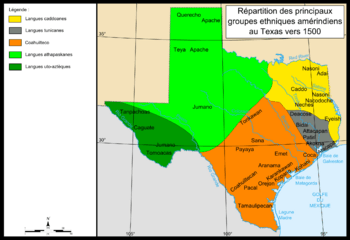Payaya people facts for kids
The Payaya people were Indigenous people whose territory encompassed the area of present-day San Antonio, Texas. The Payaya were a Coahuiltecan band and are the earliest recorded inhabitants of San Pedro Springs Park, the geographical area that became San Antonio.
History
The band are known to have inhabited the areas of the San Antonio River, the Frio River to the west, near the Pastia tribal lands; and Milam County to the east, where they lived among the Tonkawa.
The Payaya called their village Yanaguana. It was located next to the river which the Spanish named the San Antonio. Some historians believe the band referred to the river as Yanaguana, but the Spanish Franciscan priest Damián Massanet recorded this as the name of their village.
The Payaya first made contact with Spanish colonists in the 17th century, when the tribe had ten different encampments.
By the year 1706, the Spanish had converted some Payaya among the Indigenous converts baptized at Mission San Francisco Solano, 5 miles (8.0 km) from the Rio Grande in Coahuila, Mexico. Today's municipality of Guerrero is the approximate location of Mission San Francisco Solano. The Payaya were a small band of sixty families by 1709.
In 1716, the Payaya befriended Franciscan priest Antonio de Olivares. They became the mission Indians at San Antonio de Valero Mission, founded in 1718, later known as the Alamo Mission in San Antonio. The mission began assimilation of the Payaya by teaching them Spanish and trade skills. The tribe had an elected form of self-government within the mission. Infectious diseases took a high toll of the mission Payaya during the eighteenth century.
Culture
The Payaya, like other Coahuiltecan peoples, were a hunter-gatherer society. The Spanish recorded their nut-harvesting activities. Historians have speculated that the band's movements in the Edwards Plateau is an indication that pecans were a substantive diet source to the Payaya.
Spanish Franciscan priest Damián Massanet wrote his impressions of the Payaya in the June 13, 1691 entry to his diary. He described an indigenous people who were friendly toward the Spanish, but warlike and combative within their own group. Massanet described a tribal war dance, deerskin clothing, and practice of stealing horses and women from other groups. He said the Payaya were adept at learning the Spanish language, and had a fondness for Spanish clothing.
Massanet portrayed the Payaya as having a respectful attitude towards a higher spiritual power, and noted they had erected a wooden cross in their village. Massanet recounted that the day after the Spanish arrived, he and his group observed the Feast of Corpus Christi with a Mass, during which the Payaya were present.
Language
Quick facts for kids Payaya |
|
|---|---|
| Native to | Texas |
| Era | 18th century |
| Language family |
unclassified
|
The Payaya language is not sufficiently attested to classify.


